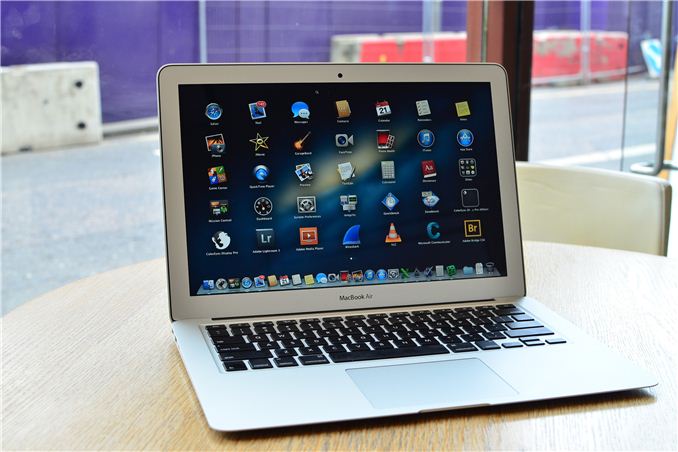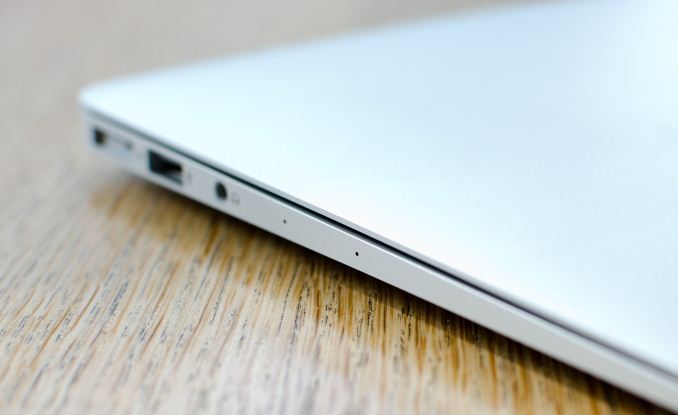The 2013 MacBook Air Review (13-inch)
by Anand Lal Shimpi on June 24, 2013 12:01 AM EST
Things didn’t go exactly as I’d expected at WWDC. I spent the week before the show at Computex, talking to PC OEMs, who had all just launched their Haswell ULT based Ultrabooks. With a couple of exceptions however, the bulk of Haswell ULT systems weren’t scheduled to ship until later this year. Even the Acer S7 I snagged while in Taipei was still a pre-production unit, with final hardware due out in the next month. Based on what I saw in Taiwan, and Intel having seeded me an Iris Pro machine the week before, I assumed that the MacBook Pro with Retina Display is what would get the Haswell treatment first. Obviously, that didn’t happen.
In hindsight, the move makes sense. Apple will sell far more MacBook Airs than rMBPs. The Apple/Intel relationship is looking very healthy these days, so it’s also not surprising that it would have supply and early enough access to Haswell ULT to launch the MBAs at WWDC with almost immediate availability. The Haswell ULT shift didn’t require a new chassis for Apple, which meant a less complex development process.
From the outside, the new MacBook Air looks nearly identical to its predecessor. There's a second mic opening on the left side of the machine now, but otherwise you'd be hard pressed to tell this year's model apart from the previous generation. Internally, nearly everything has changed.
The battery is higher capacity, with no increase in weight. Making better use of that larger battery is Intel's new Haswell ULT silicon. Since we're talking about a ULT part, the PCH moves from the motherboard to the CPU package - creating an emptier motherboard than we've seen in previous years:
The 2013 13-inch MacBook Air Motherboard, Courtesy iFixit
It's clear to me that the MBA is due for a more significant redesign, but this is not the year for that.
Alongside Haswell comes a brand new PCIe SSD, 802.11ac support and LPDDR3 memory. All at a price equal to, if not less than last year's models:
| 2013 MacBook Air Lineup | ||||||
| 11.6-inch | 11.6-inch (high-end) | 13.3-inch | 13.3-inch (high-end) | |||
| Dimensions |
H: 0.11-0.68" (0.3-1.7cm)
W: 11.8" (30cm) D: 7.56" (19.2cm) |
H: 0.11-0.68" (0.3-1.7cm)
W: 12.8" (32.5cm) D: 8.94" (22.7cm) |
||||
| Weight | 2.38 lbs (1.08kg) | 2.96 lbs (1.35kg) | ||||
| CPU | 1.3GHz dual-core Core i5 | 1.3GHz dual-core Core i5 | ||||
| GPU | Intel HD 5000 | |||||
| RAM | 4GB LPDDR3-1600 | |||||
| SSD | 128GB PCIe SSD | 256GB PCIe SSD | 128GB PCIe SSD | 256GB PCIe SSD | ||
| Display Resolution | 1366 x 768 | 1440 x 900 | ||||
| Ports | Thunderbolt, 2x USB 3.0, headphone jack | Thunderbolt, 2x USB 3.0, SD card slot, headphone jack | ||||
| Networking | 2x2:2 802.11ac | 2x2:2 802.11ac | ||||
| Battery | 38 Wh | 54 Wh | ||||
| Price | $999 | $1199 | $1099 | $1299 | ||
We've been over the MacBook Air chassis thoroughly in the past so I won't go through it again here. Build quality remains excellent. The clickpad and backlit keyboard never give me any troubles either. It's sad that we're still having clickpad issues elsewhere in ultraportables but this is one area where Apple's vertically integrated advantage is apparent (as is the company's willingness to spend a little extra on even the little details).
The only thing that hasn't changed, that perhaps should have is the display. The MacBook Air retains the same 1366 x 768/1440 x 900 panels from last year, while much of the competition has moved to at least 1080p IPS in the 13.3-inch form factor. This year at Computex we saw a number of systems move to 2560 x 1440 13.3-inch panels, at least as an option, however I'm expecting those systems to be priced more in line with the 13-inch rMBP rather than the MacBook Air. Admittedly, I don't know the right solution here.Ultra high resolution panels drive cost and power consumption up, the latter which can be offset by going to a larger battery - but then you have a 13-inch rMBP. Perhaps the right move for the MacBook Air would be for Apple to move to IPS panels at least? Or maybe we see a merger of the 13-inch MBA/rMBP, and something new entirely replace the 11-inch model.












233 Comments
View All Comments
malcolmcraft - Thursday, October 9, 2014 - link
MacBook Air is absolutely fantastic! It is also interesting that it's the highest rated laptop among consumers (see http://www.consumertop.com/best-laptop-guide/)... I would not trade mine for anything.darwinosx - Monday, July 8, 2013 - link
If you read the review you are commenting on you would know its not a terrible display.Subyman - Monday, June 24, 2013 - link
Did you even read Anand's article? He explains why.sigmatau - Monday, June 24, 2013 - link
Yes, apparently it is good to have a long battery life so you can be able to stare at a horrible display for as long as possible. I'd rather have that display in a $400 laptop. Actually, not even at that price point.designerfx - Monday, June 24, 2013 - link
exactly. I laugh when people look at GPU performance when they forget that it's at 1366x768. You can get better (and AMD does) in IGP.josef195 - Tuesday, August 20, 2013 - link
I laugh when people complain about good GPU performance at 1366x768 when it's actually 1440x900jmmx - Monday, June 24, 2013 - link
hardly a horrible display! Have you ever seen one? Not only are they very fine - though admittedly not as high resolution as others, but according to one monitor expert - only Apple displays have a consistency and an out-of-the-box color setting that is very close to professionally calibrated.sigmatau - Tuesday, June 25, 2013 - link
OK, I will say that Apple offers some of the best displays, but the best 1366x768 display is still terrible even on a 13" display. Not sure why Apple didn't go with a 1080p display with haswell since any increase battery waste from the display should be more than mitigated by the increased efficiency of the CPU/GPU. It's not like anyone does any serious gaming on these laptops so a higher resolution display will not be affected there either.KitsuneKnight - Tuesday, June 25, 2013 - link
The display is 1440x900 on the 13", not 1366x768 (that's the 11"). It's also one of the damn nicest displays I've ever had the pleasure of using (even the viewing angles doesn't bother me, maybe because it's the only laptop I've used with a decent henge).Personally, I'd opt for a 12 hour battery life over a retina-class display. Ideally, I'd have both, but it'll be quite a while before that becomes a possibility in any machine like the Air.
ThreeDee912 - Monday, June 24, 2013 - link
I'm not sure if it's the same panel, but the 2010 and 2011 reviews tested the LCD, and the panels had some of the best contrast ratios and black/white levels out of any TN panels at the time. It's no IPS, but they're still pretty darn good compared to everything else. While it would be nice if Apple made the panels IPS, I think the current panel resolution is fine.http://www.anandtech.com/show/3991/apples-2010-mac...
http://www.anandtech.com/show/4528/the-2011-macboo...
Also, I'm not sure why some people want to run an unscaled UI on super high-res panels, especially on laptops of this size. Yes, some smartphones have higher resolutions screens, but they scale things up so it's easier to read. Just stuffing in a high-res panel for the heck of it isn't the way to do things.